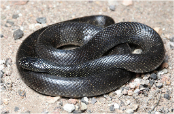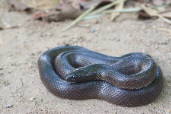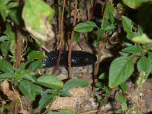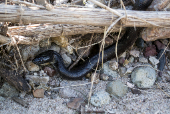Desert Kingsnake (Lampropeltis splendida)
Description: The snake's glossy dorsum is black or very dark brown colored, finely speckled with off-white or yellow. These pale flecks form dimly defined narrow vertebral crossbands, between which the intervening rectangular areas are black. Pale yellow scales may predominate along the lower sides. The abdomens of both adult and young snakes are mostly black, with white or pale yellow blotches marking the outer ends of the ventral plates. The smooth dorsal scales are arranged in 23 to 25 rows at midbody and the anal plate is undivided.
Habitat: The desert kingsnake may occur in any rural habitat within its range. Despite its common name, it is most likely to be found in mesic areas, especially near water tanks or within riparian corridors.
Range: Texas, Arizona and New Mexico. In Mexico it ranges as far west as Sonora
Found in these States:
AZ |
CA |
NM |
TX
Diet: This snake is known to be a powerful constrictor; its diet consists of mostly mice if domestic, and other rodents if wild. It also can feed on reptile eggs detected beneath the surface via smell. In part because of its resistance to pitviper venom, the desert kingsnake is able to consume young diamondback rattlesnakes that are common within its range, and at the scent of L. getula even adult western diamondbacks edge hastily backward, shielding their heads with defensive loops.
Reproduction: As with most reptiles, L. splendida lays eggs. Courtship and copulation occur between March and June, with clutches of 5 to 12 adhesive-surfaced eggs deposited in late June or July, sometimes buried as deeply as a foot to prevent drying through their moisture-permeable shells. After about 60 days of incubation, the 8- to 10-inch-long hatchlings, weighing about a fifth of an ounce, emerge. Brightly yellow-speckled in vertebral cross-lines, they also exhibit a lateral row of large, dark brown spots, which as they mature, are gradually fragmented by encroaching yellow flecks.
Status: Listed as Least Concern in view of the large extent of occurrence, large number of collection sites and locations, and because the species is unlikely to be declining fast enough to qualify for listing in a more threatened category.
»» Kingdom: Animalia - Animals
»» Phylum: Chordata - Chordates
»» Subphylum: Vertebrata - Vertebrates
»» Class: Reptilia - Reptiles
»» Order: Squamata - Scaled Reptiles
»» Suborder: Serpentes
»» Superfamily: Colubroidea
»» Family: Colubridae - Colubrids
»» Genus: Lampropeltis
»» Species: Lampropeltis splendida - Desert Kingsnake
This article uses material from the Wikipedia article "Desert Kingsnake", which is released under the Creative Commons Attribution-Share-Alike License 3.0. Content may have been omitted from the original, but no content has been changed or extended.
|








